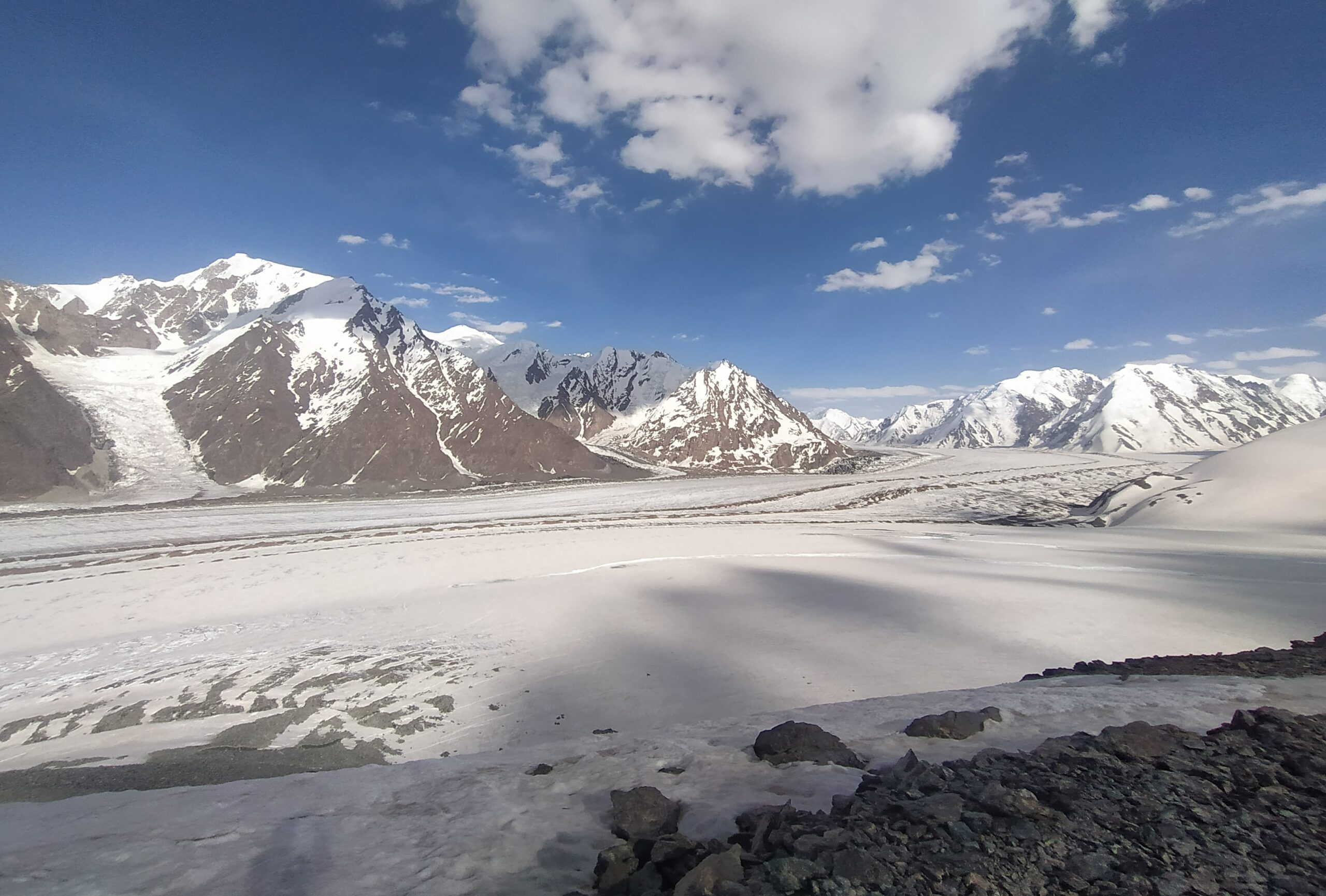The Pamir Mountains are located in a region that influences hemispheric-scale climate and is expected to experience major environmental changes as a consequence of warming, land use and water demand. Yet, central Asia’s climate is one of the least constrained globally, because of an extreme scarcity of present and past climate data and the complexity of atmospheric circulation patterns.
Ice cores from high-mountain glaciers can provide unique archives of detailed past climatic and environmental conditions. In a region such as the Pamirs, where instrumental data, historical documents and other paleoclimate records are scarce, this represents a key resource to understand past and present climate.
The Climate and Environmental History Research Cluster of the PAMIR programme initially chose the accumulation area of Fedchenko Glacier as the coring site. Fedchenko Glacier is one of the largest glacier systems in High Mountain Asia and its potential as a climate archive was recognised early on. Previous studies on a first shallow core have shown that this site has enormous potential for obtaining an ice core paleo record covering at least the last millennium with high temporal resolution. Since that initial study, no other attempts to collect a deep ice core have been successful, due to very difficult access and extremely challenging logistics.
Taking into consideration these immense logistical challenges of coring Fedchenko, the PAMIR research team has investigated several sites in the region and identified the Kon Chukurbashi Glacier as a valid alternative site for extracting an ice core. The extraction of the deep ice core from the Kon Chukurbashi Glacier is planned for the 2025 field campaign.
If successful, the ice core will allow reconstructing past changes in snow accumulation, precipitation origin, and regional scale atmospheric dynamics. It will provide novel data evidence to test the competing hypotheses that have been put forward to explain the unique state of the cryosphere in the region: increased precipitation at high elevations due to enhanced Westerlies, summertime cooling, or an increase in summertime precipitation due to irrigation in the agricultural regions adjacent to the Pamirs. It will provide a novel archive documenting air pollution and early human impact, e.g. from mining activities.
Ideally, the ice coring research will be complemented with cosmogenic exposure datings of boulders exposed after glacier retreat in a number of glacial valleys transecting the Pamir Mountains from West to East. With such cosmogenic exposure dating of boulders, the aim is to improve the knowledge of paleo-glaciological history during the last 10,000 years.
Glaciers are now recognised as a distinct biome with its particular microbial life. Within the PAMIR research consortium we will therefore attempt to use parts of the ice core to study the ice-locked microbial life. The use of cell counts, 16S rRNA amplicon sequencing and metagenomics of sample layers throughout the core will shed light on the responses of microorganisms to climatic variations and air pollution, and will greatly expand our understanding on the evolutionary history and adaptive traits of bacteria within the icy archive.
Glaciers are also major repositories of dissolved organic matter (DOM). Therefore, the aim is to use ultrahigh-resolution mass spectrometry on ice aliquots to characterise the molecular composition of the DOM. This will provide novel knowledge on the sources (e.g., microbial versus dust) and diagenesis of the icelocked DOM.
Swiss Cluster Participants
Margit Schwikowski (PSI and University of Bern): Cluster PI until her retirement in 2023.
Martin Hoelzle (University of Fribourg): Cluster PI after the retirement of Margit Schwikowski in 2023.
Evan S. Miles (University of Zurich and University of Fribourg)
Tomas Saks (University of Fribourg)
Enrico Mattea (University of Fribourg)
Andreas Henz (University of Zurich)
Theo Jenk (PSI)
Anja Eichler, Senior Scientist (PSI)
Tom Battin (EPFL)
Christoph Raible (University of Bern)
François Burgay (PSI)
Local Partners
Nasrialo Sheralizoda (Academy of Sciences of Tajikistan, Centre for Research on Glaciers); Director of the Centre
Jovidon Davlatov (Academy of Sciences of Tajikistan, Centre for Research on Glaciers); Field expert
Diloram Kayumova (Academy of Sciences of Tajikistan, Centre for Research on Glaciers); stable water isotope analysis
Abdulhamid Kayumov (Academy of Sciences of Tajikistan, Centre for Research on Glaciers); Pamir glacier expert
International Partners
Koji Fujita (Nagoya University, Japan); glaciology
Sumito Matoba (Hokkaido University, Japan); ice core and climate research
Yoshinori Iizuka (Hokkaido University, Japan); ice core and climate research
Stanislav Kutusov (Ohio State University, US); ice core and climate research
Ivan Lavrentiev (joins as a private individual; Russian Academy of Sciences); ice thickness measurements
Francesca Pellicciotti (ISTA, Austria)
Christoph Mayer (BADW, Germany); glaciological survey for drilling site selection
Astrid Lambrecht (BADW, Germany); glaciological survey for drilling site selection
Fanny Brun (IRD, France); glaciological survey for drilling site selection
Robert Spencer (SU, USA); ultrahigh-resolution analyses of ice-locked DOM
Flory Kern (Director of Ski Berge Abenteuer GmbH, Germany); logistics
